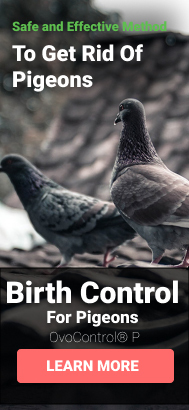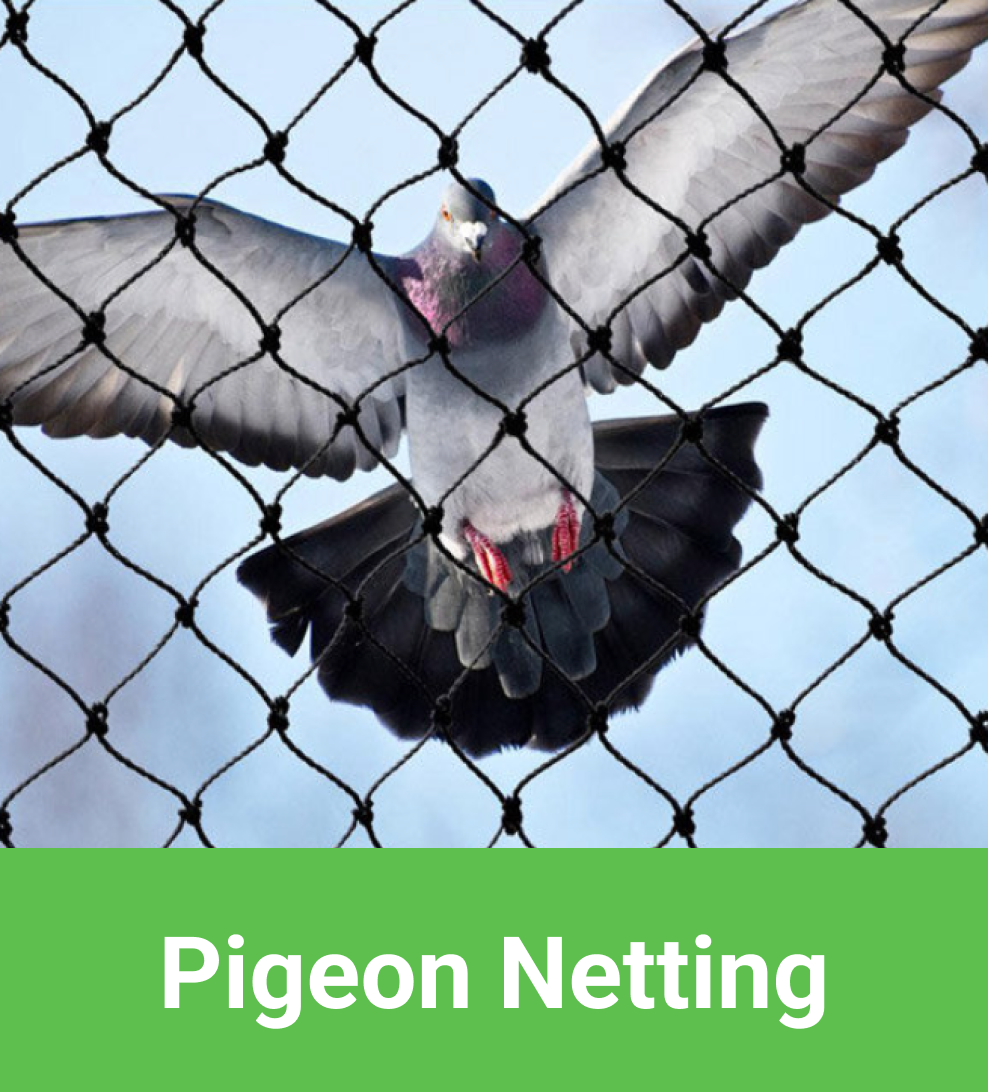Bird Netting: Everything you Should Know
Written by Erick Wolf
For facility managers, pigeons are notorious for getting out of hand quickly. Fortunately, even before things get out of control, various solutions exist to help control the number of birds at an impacted site.
Bird exclusion netting is one solution to manage pigeons and prevent them from accessing areas where they can obtain food and continue growing their population. In this article, we’ll look closely at bird netting types and discuss the pros and cons to see if this is the ideal solution for your pigeon problem.
What is Bird Netting?
Bird netting, also known as pigeon netting, is a type of bird control measure that involves the use of nets to prevent birds from accessing certain areas. Bird netting is commonly used to protect crops and buildings from bird damage. It can also be used to keep birds away from other areas such as agricultural and industrial applications and facias of buildings.
Bird netting is made from various materials, including nylon, polyethylene, and stainless steel. The type of bird netting you choose will depend on the specific needs of your application. Nylon bird netting is often used for agricultural applications as it is lightweight and easy to install. Polyethylene bird netting is more durable and is often used in industrial settings. Stainless steel bird netting is the strongest type of bird netting and is commonly used in areas where bird control is of paramount importance, such as airports.
Types of Bird Netting and Where they are Used
There are various types and styles of bird netting available, so it is essential to understand the different options before selecting the right product for your needs.
| Bird Netting Type | Product Material | Purpose |
| Pop-up bird netting | Polyethylene | Keep birds out of berries and greens in the gardens |
| Wire Crop Coop | Low carbon steel | Keep birds and other animals, like bunnies, deer from ruining the garden |
| Crop Cage | Powder-coated steel frame, polypropylene, polyethylene, polyester | Keep birds and other animal pests away from ripening berries in the gardens |
| Wire Super Dome | Low carbon steel | Keep birds out of the taller crops |
| Wire Row Cloche | Galvanized steel wire | Protect prized seedlings and lettuce plants from birds |
| Wire Cloche | Steel | Protect the entire rows of seedlings against birds |
| No-Knot Bird netting | UV protected, polypropylene knotted netting, rot proof, and waterproof | Blocks birds from entering unwanted areas like roofs, warehouses, and other exposed enclosures |
Where is Bird Netting Most Commonly Used?
Crop protection - bird netting is a physical barrier that covers the entire crop, making it difficult for birds to access the plants. It is an essential tool for crop protection, as it can help prevent significant losses when birds damage crops.
Fish protection - Bird netting is the perfect solution for protecting our fisheries and wildlife reserves from pesky birds. Fish farms need protection, too, so they use netting that will be visible as a barrier to diving into your pond!
Building protection - Bird netting is a highly effective and long-lasting way to protect buildings from all sorts of birds. It provides an impenetrable barrier that doesn't harm the creatures inside it while keeping out unwanted guests.
Mining ponds - Bird netting can be used to prevent the spill on the roads, such as minerals or metals from crushed rocks. These compounds must be confined so they don't escape, but EPA regulations also mandate that these cyanide ponds be covered at all times to prevent wildlife loss!
How Bird Netting Works for the Pigeon Problem
According to the Humane Society, preventing roosting and nesting opportunities for the birds is one of the humane methods of pigeon control. Your efforts should encourage the birds to nest and roost elsewhere.
Since pigeons look for flat surfaces for nesting and roosting, bird netting helps to eliminate these opportunities and forces them to look elsewhere. In a perfect world, you can create a pigeon-free environment using large pigeon netting, especially in large industrial structures.
Bird netting can be used for many applications, including:
Within recessed portions of buildings
In light wells
Under eaves
Around equipment
Pros and Cons of Bird Netting + Alternatives
There are pros and cons to opting to use bird netting for your facility. It’s crucial to weigh the pros against the cons to ensure it is the right choice of bird control for you and your operations.
Bird Netting PROS
It’s time to take a closer look at some of the advantages of this method of control now that you have a better idea of how pigeon netting works.
Suitable for larger areas
Long-lasting (up to 15 years)
Environmentally safe
Effective against most bird species, including pigeons
Bird Netting CONS
Of course, you also need to look at some of the drawbacks of using bird netting for your facility.
It becomes counterproductive if there are gaps or holes
Nets may not be cost-effective at your facility
Many facilities, especially ones with open doors, cannot be netted
Accurate installation is costly, time-consuming, and very difficult
Bird Netting Alternatives
If you're looking for bird netting alternatives, here are a few options to consider:
“OvoControl P” as a Better Alternative or Adjunct for Pigeon Netting
In addition to the recommendations provided by the Humane Society for humanely controlling pigeon populations, another method that is becoming increasingly popular is using pigeon birth control, such as OvoControl.
Often, the first few steps are not enough, including limiting feeding, removing unintentional food sources, preventing roosting, and nesting, or limiting flock size. To ensure that you can get the population under control, pigeon birth control can also be applied.
How Does OvoControl Work?
OvoControl interferes with egg fertilization. It comes as a kibble-type pigeon food form. OvoControl treated pigeons lay unfertilized eggs. The active ingredient of the contraceptive, nicarbazin, has been used in chickens to prevent enteric disease for decades.
Where Did the Concept of OvoControl Originate From?
Understanding OvoControl means understanding where the concept of pigeon birth control came from.
Since they are year-round nesters, a single pair of pigeons can quickly raise twelve or more young annually. In urban developments where space and food are readily available, you’ll see these numbers start to increase significantly.
In an effort to find a way to control the pigeon population, researchers took to the development of a bird contraceptive to function similarly to how it does in humans. The results of this research created the product known as OvoControl from the American company Innolytics, LLC.
Pros of using Birth Control for Pigeons
Now that you have a better idea of how birth control for pigeons works, it’s time to look at some of the advantages of opting for this method of population control.
VARIOUS FEEDING METHODS
A primary benefit of using OvoControl is that you can feed pigeons using various delivery methods, making it more convenient for broader applications.
Automatic feeders
Hand Feeding
NON-TOXIC ACTIVE INGREDIENT
Used in chickens for decades, the active ingredient of OvoControl is nicarbazin. Initially developed in 1955 by Merck, nicarbazin has been an FDA-registered anticoccidial for chickens for over sixty years.
The side effect impacted an egg’s hatchability when nicarbazin was administered to breeder chickens during the research. To develop effective birth control for pest birds, including pigeons, Innolytics researchers applied this information, known to be an unwanted side-effect in chickens.
HUMANE PIGEON FLOCK SIZE CONTROL
By reducing the hatch rates, OvoControl has proven to effectively limit the flock sizes of pigeons. You can rely on the advanced developments of this pigeon birth control to diminish any problems associated with large flocks of pigeons.
Learn more about pigeon control alternatives:
- Pigeon Culling Methods: Poisoning, Shooting, Traps and Raptors
- Reducing Pigeon Reproduction: A Long-Term Solution for Pigeon Control
- Physical Exclusion of Pigeons – Spikes, Wires, Nets and Slides
- Pigeon Deterrents - Effigies, Sonic Emitters, Propane cannon
- Bird Netting: Everything you Should Know



